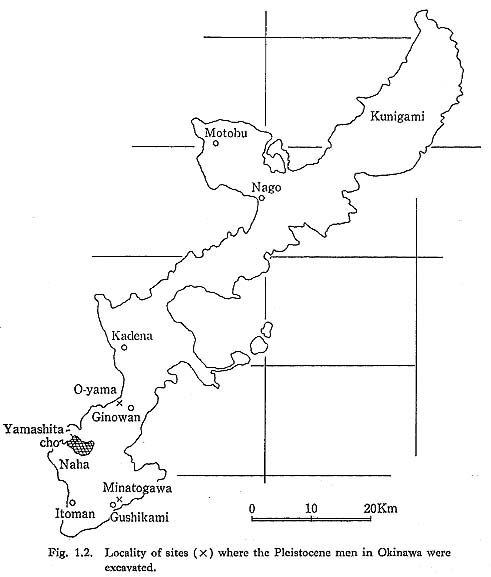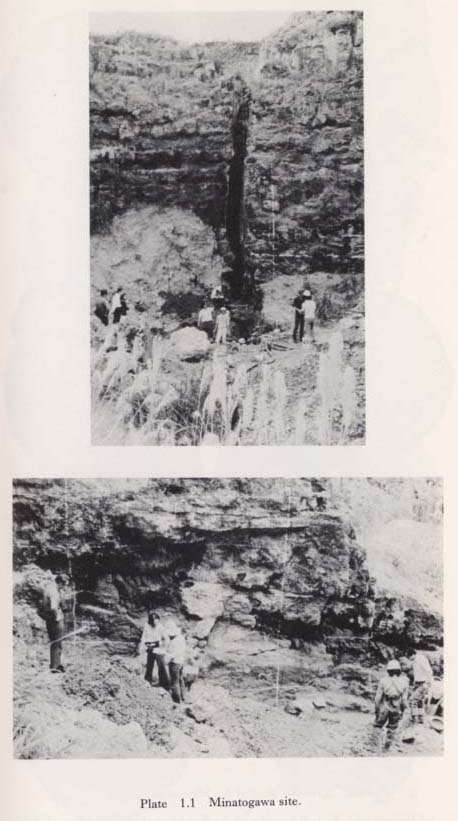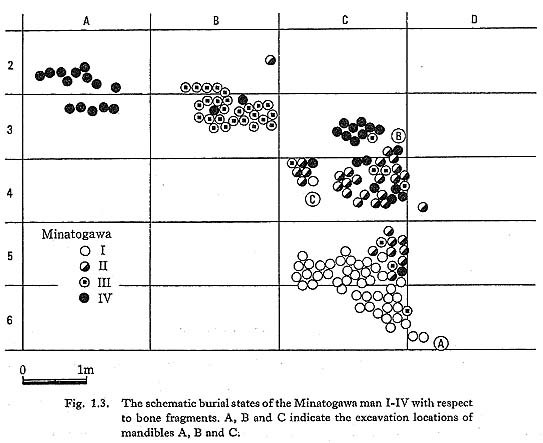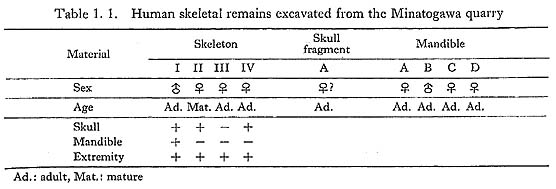CHAPTER 1
Introduction
Hisashi Suzuki
Professor Emeritus, The University of Tokyo; and
Professor, Sey'o University
and
Giichi TANABE
Professor, The Ochanomisu Woman's College
|
The island of Okinawa is composed of old raised coral reefs. The remains of some extinct species of mammals-elephant, deer, rat etc.-have been found in the Pleistocene deposits of limestone caves that developed by natural erosion. Through the discovery of these extinct mammals, which are considered to be the same species as those of the Asian continent, it is commonly recognized that the Ryukyu island chain as a whole was connected with the continent in the Quaternary Period. The possible connection of the Ryukyu Retto or Nansei Islands (a chain of islands stretching from Japan to Taiwan which includes Okinawa and Satsunan Islands) with the Asian continent in the Quaternary was actually proven by the discovery of fossilized bones of extinct mammals such as deer and Naumann's elephant on two islands of the Ryukyu Retto: Okinawa and Miyako (Fig. 1. 1). This naturally enhanced the possibility that remains of Pleistocene man and Palaeolithic culture could be found throughout the Ryukyu Retto. Expectations of this were realized archaeologically in the mid-1930s, and anthropologically in the 1960s. In 1936, Tokunaga reported that bones of extinct deer had been discovered along with bone artifacts in the Katabaru cave on Iyejima Island, 5 km west of Okinawa; however, no human bones were discovered at that time (Tokunaga, 1936). In 1962, Tawada discovered in the same cave a human parietal bone and stone implements, presumably chopping tools (Takamiya, 1965). In the same year, Takamiya discovered a large number of deer fossils, bone artifacts, and an ash seam in the Yamashita-cho limestone cave in Naha City, Okinawa (Takamiya, 1968).
In 1966, S. Taira in Naha City brought 3 fossil human bones to the writer; these had been found incidentally by laymen in the following limestone caves: Taking the fluorine content, the degree of fossilization and other morphological characteristics of these bones into consideration, the present writer has estimated that, of the human bones from the three caves, the Oyama mandible is the oldest, probably from the Pleistocene Age, followed by the Katabaru parietal bone and finally the Tobaru. man (Suzuki, 1975). In 1967, S. Oyama, while working at the Minatogawa limestone quarry 10 km southeast of Naha City, chanced upon the first well-preserved human fossils in the fissure deposits there. These findings led to the systematic excavation of the Yamashita-cho cave site (1968) and the limestone fissure deposits of the Minatogawa quarry (1968-74) by groups of specialists. Fossilized human and animal bones were found in both sites. The bones from the Yamashita-cho cave site were determined to be 32,000± 1,000 years B.P. (TK-78) (Kobayashi et al., 1971) and those from the Minatogawa cave site 18,250±650 years B.P. (TK-99) (Kobayashi et al., 1974) and 16,600±300 years B.P. (TK-142) (personal communication) by the C-14 dating method. The present report deals with the anthropological study of the Minatogawa man and the geological study of the Minatogawa fissure site. SiteThe Minatogawa limestone quarry is located about 10 km southeast of Naha City on the eastern coast of the Gushikami village of the southernmost part of the mainland of Okinawa (Fig. 1. 2).
In the Gushikami area there is a long fault of a few km running about in a northeastsouthwest direction; its southern end is exposed as a fissure 20 m high and 1 m -wide on the cliff of the quarry. The fissure deposits consist of reddish-brown clay with limestone breccia, in which many fragments of human bones are found mixed randomly with those of wild boar and deer. In 1967, Mr, Seiho Oyama, an Okinawan businessman, bought limestone blocks from the owner of the Minatogawa quarry in order to build the foundation of his garden, and he accidentally discovered that these blocks contained fossilized mammal bone fragments. He immediately went to the quarry and found fossiliferous layers in the fissure deposits. He observed the quarrying work at Minatogawa for almost two years, watching for the discovery of human bones. In 1966, he pointed out at last the longexpected human bone fragments in the limestone blocks, which he brought to the writer in 1968. Taking advantage of this opportunity, systematic excavations were carried out for three seasons in 1968, 1970 and 1974 in collaboration with specialists of physical anthropology, geology, palaeontology and archaeology from mainland Japan and Okinawa (see Pl. 1. 1).
The excavation was carried out by the coordinate system, setting the datum lines so that the abscissa (x) was parallel to the horizontal direction along the exposed surface of the fissure deposits and the ordinate (y) perpendicular to it. The excavation area was demarcated by x lines (2-meter units designated A,B,C,D, and E from east to west) and y lines (1-meter units designated 1 to 6 going from top to bottom) into blocks 2 square meters each, designated as A5, B6, etc. (see Fig. 1. 3).
The human bones discovered during these seasons of excavation are those of no less than 5 and no more than 9 individuals; two of these are males and the others females. The human skeletal remains excavated from the Minatogawa fissure site are listed in Table 1. 1.
Burial state of skeletal remains at the sitesNo human bones were excavated in areas A1 to D1. Most of the skeletons were found in the region beginning at the top of area A2 and sloping down obliquely to area D6. Figure 1. 2 shows the schematic burial states of 4 skeletons with respect to bone frag ments in the sites. The complete skeleton of Minatogawa I was buried in an almost anatomically normal state, standing on its head. The fragments of Minatogawa IV skeleton were scattered roughly in two groups areas A2-3 and C3-4, as determined from the reconstruction of the whole skull and extremity bones. Two other skeletons were also found in scattered states, as in the case of skull No. 4. |




